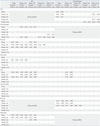Abstract
Purpose
Materials and Methods
Results
Figures and Tables
Fig. 1
Whole spine AP (A) and lateral (B) radiography after anterior cervical discectomy and fusion with cage only (Zero-P implant; Synthes GmbH Switzerland, Oberdorf, Switzerland) with autobone.

Fig. 2
Whole-spine AP (A) and lateral (B) radiography after anterior cervical discectomy and fusion with cage and plate [Allobone spacer (CG bio, Seoul, Korea), and Zephir plate (Medtronic Sofamor Danek Inc., Memphis, TN, USA)].

Fig. 3
Radiologic parameters evaluated in this study. Cervical lordosis (Cobb angle between caudal endplate of C2 and caudal endplate of C7), thoracic kyphosis (Cobb angle between cranial endplate of T4 and caudal endplate of T12), lumbar lordosis (Cobb angle between sacral upper margin and cranial L1 endplate), sagittal vertical axis (distance between vertical lines through the center of the C7 vertebral body and the S1 superior posterior corner), pelvic incidence (angle between the line joining the center of the femoral head with the midpoint of the sacral endplate and the perpendicular line from the midpoint of the sacral endplate), pelvic tilt (angle between the line joining the center of the femoral head with the midpoint of the sacral endplate and the vertical line), and sacral slope (angle between the line along the sacral endplate and the horizontal line).

Fig. 4
Summarized correlations among sagittal vertical axis (SVA), cervical lordosis, pelvic tilt, and sacral slope. SVA was negatively correlated with cervical lordosis and sacral slope and positively correlated with pelvic tilt. Cervical lordosis was negatively correlated with SVA. Pelvic tilt had a positive correlation with SVA and a negative correlation with sacral slope. Sacral slope had a negative correlation with SVA and pelvic tilt.

Fig. 5
Significant radiologic parameters changes according to postoperative time. Preoperative and postoperative states were compared within groups using the Wilcoxon signed-rank test. *p<0.01, †p<0.05.

Table 1
Demographic Data

*Cage only group received a Zero-P implant (Synthes GmbH Switzerland, Oberdorf, Switzerland) with autobone.
†Cage & plate group received an allobone spacer (CG Bio, Seoul, Korea) and Zephir plate (Medtronic Sofamor Danek Inc., Memphis, TN, USA).
‡Patients were divided into two groups according to cervical lordosis angle: high C-lordosis (>mean preop. cervical lordosis -12.5°) and low C-lordosis (<mean preop. cervical lordosis -12.5°).
Table 2
Radiologic Parameters Preoperatively and at 1, 3, 6, and 12 Months Postoperatively

SVA, sagittal vertical axis.
Intragroup preop. versus postop. comparisons were performed using the Wilcoxon signed-rank test; *p<0.01, †p<0.05.
Intergroup comparisons were performed with the ‡Mann-Whitney test; p<0.01, §p<0.05.
∥Patients were divided into two groups according to cervical lordosis angle: high C-lordosis (>mean preop. cervical lordosis -12.5°) and low C-lordosis (<mean preop. cervical lordosis -12.5°).
Table 3
Significant Correlations* among Radiologic Parameters





 PDF
PDF ePub
ePub Citation
Citation Print
Print


 XML Download
XML Download